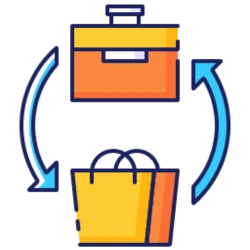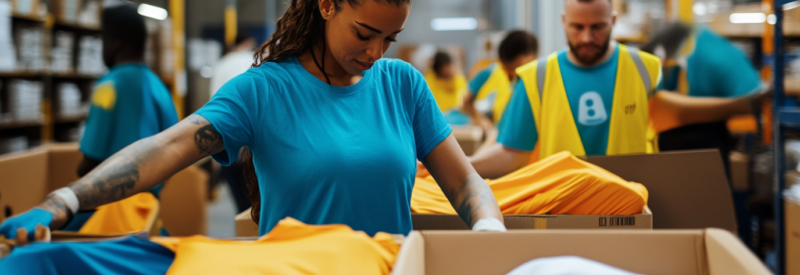
If you’re selling branded merchandise—whether t-shirts for your popular restaurant, sports or band memorabilia, or any other original design work—you know what a hassle it can be to fill custom orders when the purchases start piling in. In these instances, you’ve likely scoured the internet for tools to help crank orders out quicker. You might have explored Shopify & Printify to expedite delivery.
The bad news is none of these are likely to be your magic cure, no matter what rave reviews you see online. However, the right combination of tools can boost your business and reduce turnaround times. Here, we’ll unpack how Shopify and Printify work together to enhance your business. Hand-in-hand, they can help improve your merch production game.
Printify & Shopify: As Complements, Not Competitors
Kicking off any eCommerce store naturally starts with a web hosting platform. When you search for the right one for your business, a bounty of options will likely appear—Shopify and Printify are included. At the same time, Shopify is a great eCommerce site host (we’ll outline why below), and Printify as a web hosting solution is somewhat mischaracterized.
While the two are well-known names, each platform serves different entrepreneurial needs. Shopify is designed to be an all-in-one, scalable eCommerce solution for entrepreneurs aiming to establish and grow an online store. It encompasses a full suite of tools necessary for eCommerce, from setting up the store’s aesthetics with customizable templates to managing payments, orders, and marketing.
Printify, on the other hand, primarily handles production. It offers a rudimentary “pop-up shop” feature but works best when integrated with a web hosting platform like Shopify. While you use Shopify (or whichever platform you choose) to build your site and manage sales and marketing, you can pair with Printify to streamline inventory logistics.
Printify eliminates the need for inventory management by partnering with a network of print providers who handle production and shipping. The platform boasts a wide range of customizable products and collaborates with expert providers to ensure quality.
While they may seem to be competitors, Shopify and Printify make far more sense paired together. Let’s explore how each one works.
Shopify: Home Base For eCommerce Operations
Shopify functions as a subscription-based multichannel commerce platform and site host, explicitly designed with eCommerce in mind. It’s meant to accommodate businesses of all sizes, from small mom-and-pop operations to large corporations, offering a range of tiered subscription options.
For example, you can start with the Basic Plan to get your business off the ground; you might switch to the Shopify or Advanced Plan as things scale up. Finally, the platform offers Shopify Plus, a more customized enterprise-level version.
While each of these plans has its specialties (and you should check out our guide to get into the fine details), what’s more appealing is the commonalities across them. No matter your tier, Shopify aims to serve as a one-stop hub for all your eCommerce business needs, providing hundreds of customizable site templates and thousands of potential Shopify integrations in its App Store.

While you can find an app for nearly every use under the sun in the App Store—Printify included—Shopify also keeps many essential eCommerce features in-platform. Shopify offers a proprietary payment gateway, Shopify Payments, to spare you the hassle of finding a payment partner; it also accommodates over 100 different third-party payment processors if you choose. If you have a physical component to your store, a homegrown POS system can help you seamlessly merge the two aspects of your business.
A user-friendly dashboard helps you navigate processing, inventory, shipping, and other eCommerce essentials like marketing and SEO functionalities. Detailed sales reports help you track trends and KPIs over time so you can make data-backed decisions every step of the way.
Printify: Your Production Master
While Shopify aims to be an eCommerce jack of all trades, Printify is significantly more targeted. It’s also a subscription service with three affordably-priced tiers depending on the volume of printing you need. As far as actual production goes, Printify runs on a pay-as-you-go model, which is especially helpful for drop shipping businesses. Printify manages your business’s output when someone orders and ships directly to the customer.
Since Printify outsources production to its designers on demand, this eliminates the need for comprehensive inventory management (one of the most laborious parts of running a merch store). Think of it as just-in-time manufacturing for your eCommerce store. As it uses a network of print providers across various regions, shipping times become somewhat market-agnostic; Printify will ensure that products arrive promptly regardless of where your orders come in from. This mainly helps businesses planning to scale quickly.
Printify allows businesses to set up rudimentary “pop-up shop” eCommerce sites. However, these are the most basic digital storefronts, with limited customization and lacking marketing functionalities or integrations. Printify focuses on alleviating order production and fulfillment processes and works best when paired with a platform like Shopify, offering comprehensive store management.
Find the Best Platform for Your Business
As outlined, Shopify and Printify are not competitor products—they’re complimentary. Shopify helps you manage your store as a central command deck, while Printify shines as a production powerhouse. You can merge the two services seamlessly via the Printify integration in the Shopify store. Together, they‘ll streamline your custom merch store from storefront setup to order delivery.
Of course, these aren’t the only tools you’ll need for an effective business. Offering convenient payment options is essential for your eCommerce store to thrive, whether selling on a small scale or globally. The right payment processing solution can help boost sales and reduce fees.
PaymentCloud provides tailored payment processing services for businesses of all sizes, aiming to minimize transaction costs. With a secure, PCI-compliant platform, quick transaction handling, and seamless integration with platforms like Shopify, WooCommerce, BigCommerce, Magento, and Volusion, we provide customized solutions to fit your needs and support your company’s growth. Start building your eCommerce business today!
Printify & Shopify FAQs
Can You Use Printify and Shopify Independently?
Yes. As we’ve highlighted, the two serve different purposes. You can set up a Shopify store and even sell customized merchandise without Printify, making production and shipping substantially easier.
Likewise, you can set up an eCommerce store via the Printify Pop-Up Shop feature to sell your products independently. However, customization and marketing functionalities are minimal (and, in some respects, nonexistent). That’s why we recommend using the two together.
Is Printify Only for Print-On-Demand Items?
Yes, Printify specializes exclusively in print-on-demand services. If you wish to sell non-print-on-demand products and those offered through Printify, you must manage these products separately within your chosen eCommerce platform, such as Shopify.
Can I Migrate From Printify to Shopify—And Keep My Existing Products?
While it’s not migration in the traditional sense, you can integrate your Printify products with an existing Shopify store. Shopify provides Printify integration directly into its App Store. Installing this will merge your accounts and products under one umbrella storefront. Thus, it’s more about synchronization than migration.







